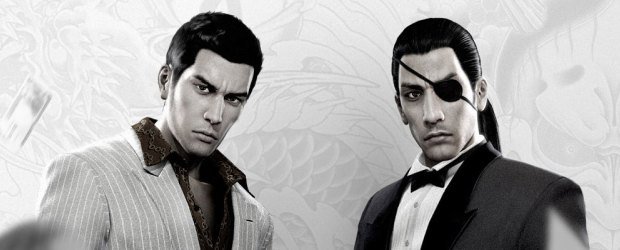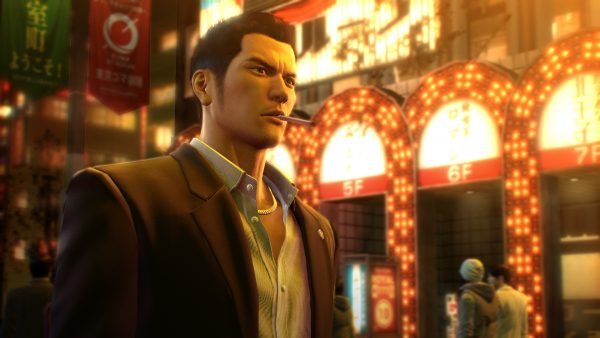Switch to: German
In these parts, the long-established gaming company named SEGA is first and fore most known for the ambitious but unsuccessful console “Dreamcast”. And Sonic SEGA’s personal mascot, the hedgehog. It looks much different in the country the company originates from and we’ll show you why that is. In 2005 Ryû Ga Gotoku (Engl: “Like a Dragon”) hit the Japanese gaming market like a bomb and was heavily acclaimed. The action adventure with cinematic story telling for the Playstation 2 managed to score 37 out of 40 points in the Japanese magazine Famitsu. It sold over half a million copies on the Asian market in only two years. The passionate and loyal protagonist Kazuma Kiryu takes the world of Asian organized crime head on, never forsaking his ideals in the heat of battle. While using his fists and legs as his main weapon, the pillars of the very elaborate battle system, a highly dramatic and emotional story unfolds before his very eyes.
About one year later the Company SEGA decides to localize Ryû Ga Gotoku as Yakuza in the west with very different results. Not only thanks to their unfitting localization of the game. For example none other than Hollywood actor Mark Hamill as Goro Majima and Michael Madsen as Futoshi Shimano were hauled in. Despite their voice acting talent the characters in the actual game fell flat and remained a laughingstock for most who anticipated the release. The promotional videos of those voice acting impressions are still on your prominent media channels to this day.
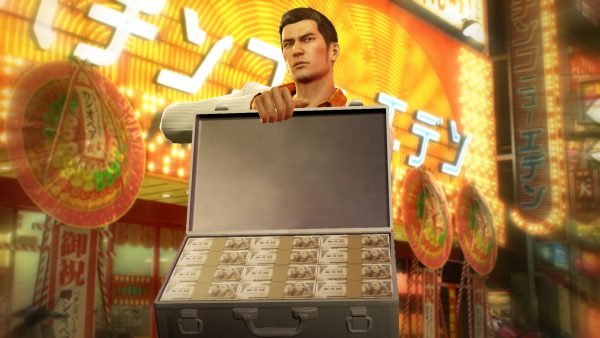
This marks the start of the long lasting Yakuza game series, despite the mistake SEGA made in terms of sound direction and localization. The lifecycle of the Playstation 2 and 3 they decided to push four more games out in the span of one to three years after the original Japanese release. Kenzan and Ishin! which sadly remained Japanese exclusives to this day, are only available to the extremely dedicated audience; those who are either able to read Japanese or are willing to put up with translation sheets/English translated videos throughout their gaming experience.
Yakuza 0, released on the 24 of January 2017 in North America and Europe marks the first chapter of the entire series for the PlayStation 4. We’re glad to state here that the series prequel, unlike Yakuza 5, managed to go retail as well. SEGA decided that North America had the pleasure of receiving a highly limited “Business Edition” including not only the game itself but a stainless steel business card holder. The piece of steel not only includes three cards of the protagonists and hostesses straight out of the game, it also sports Kazuma’s and Goro’s “Irezumi” tattoo designs on the front and backside. Koch Media chose to be the distributor outside of North America (NA) and chose to leave the special gimmicks of the business edition exclusively for them. But this means you can get the game for about half the price of the NA version of the game.
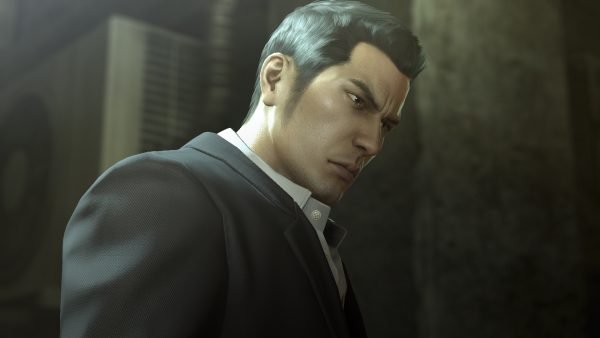
Story
In Yakuza 0 we are able to see the beginnings of the Kazuma Kiriyu, the all-time poster child of the series. In over 12 years, Takaya Kuroda lends his edgy and rough voice to our well-built Protagonist with his usually gelled and styled hairdo. In the age of TV shows and comic book adaptions it is not unusual that even videogames nowadays chose the belated route to the prequels of the series. The origin story of various already established and detailed characters, so to speak. And thus here we find ourselves in the December of 1988 where the barely 20-year-old Kiryu not only finds or fights his way through the clans of Tokyo’s underworld and himself, but also rises up to be the famous Dragon of Dojima, whom we know.
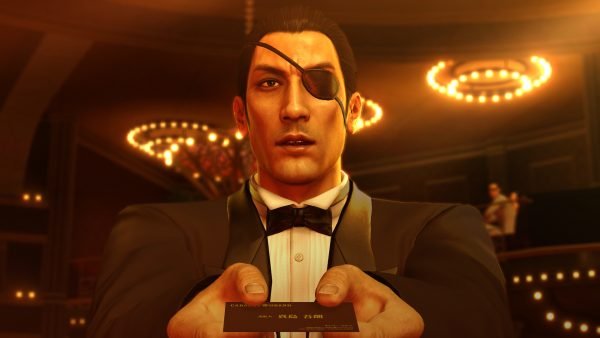 Kiryu is part of the Tojo Clan who reigns over most of Tokyo in this day. Inside this clan there are different families who fight for power inside the organization itself. Here Kiryu is part of the “Dojima” Family, the one who holds the monopoly in terms of power. At the beginning of the game our Kiryu fights a man in a suit and it is unclear if he has a hand in his death or which motives the attack hold. He quickly gets accused of killing the man and has no other option as to return the pin of the Tojo Clan, look for the conspirators, and find out why the crime scene is suddenly the most wanted lot in all of Kamurocho. The city “Kamuroucho” in the game is a fictional entertainment district in Tokyo which is based upon none other than Kabukicho in Japan.
Kiryu is part of the Tojo Clan who reigns over most of Tokyo in this day. Inside this clan there are different families who fight for power inside the organization itself. Here Kiryu is part of the “Dojima” Family, the one who holds the monopoly in terms of power. At the beginning of the game our Kiryu fights a man in a suit and it is unclear if he has a hand in his death or which motives the attack hold. He quickly gets accused of killing the man and has no other option as to return the pin of the Tojo Clan, look for the conspirators, and find out why the crime scene is suddenly the most wanted lot in all of Kamurocho. The city “Kamuroucho” in the game is a fictional entertainment district in Tokyo which is based upon none other than Kabukicho in Japan.
Our second playable character is Goro Majima. He on the other hand is part of the “Shimano” family inside of the aforementioned Tojo Clan. After his betrayal to Finto Shimano (those who played Yakuza 4 were able to see this in a flashback) he’s tortured for years and lastly banished to Sotenbori, the equivalent of Kamurocho’s in Osaka. Here he owns a Nightclub and is known as the famous “Lord of the Nightlife”. Not too long after that Majima gets a mission to snuff out somebody named “Makoto Makimura” and seems to find a bald headed man who proclaims himself as the target. But not much later Majima finds out that his actual target was none other than a blind young lady and not the bald headed man. Quickly the woman takes a center roll in the story of Yakuza 0 and proves to be very relevant to the plot and recent happenings.
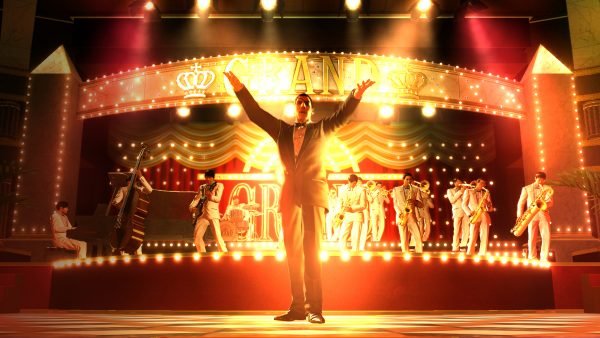 In the Yakuza series the player is usually confronted with a vast amount of clans, families and their representatives, which proves very difficult to follow at first, especially when you take the complex plot into consideration. SEGAs story writers of Yakuza 0 take a different approach this time around. Don’t be mistaken, you will still be able to meet and greet many characters but only a handful of those are actually relevant to the story. This makes it easier for newcomers to follow everything in the game more easily which much less confusion. Those who follow the story completely will be rewarded with many emotional moments, twists and turns as well as a satisfying conclusion to the ongoing plot of the game. Long-lasting fans of the series can be excited about small homages and allusions that let them anticipate upcoming events in the franchise even more. All in all you can very well say that the story of Yakuza 0 is one of the best in recent years thanks to it’s unique presentation, the very well written dialogues, profound character building and the funny moments to lighten up the mood.
In the Yakuza series the player is usually confronted with a vast amount of clans, families and their representatives, which proves very difficult to follow at first, especially when you take the complex plot into consideration. SEGAs story writers of Yakuza 0 take a different approach this time around. Don’t be mistaken, you will still be able to meet and greet many characters but only a handful of those are actually relevant to the story. This makes it easier for newcomers to follow everything in the game more easily which much less confusion. Those who follow the story completely will be rewarded with many emotional moments, twists and turns as well as a satisfying conclusion to the ongoing plot of the game. Long-lasting fans of the series can be excited about small homages and allusions that let them anticipate upcoming events in the franchise even more. All in all you can very well say that the story of Yakuza 0 is one of the best in recent years thanks to it’s unique presentation, the very well written dialogues, profound character building and the funny moments to lighten up the mood.
Yakuza 0’s storyline is displayed in typical true-to-it’s-core manner with the usually very intricate and elaborate story sequences that mostly run on the actual engine of the game itself. Scenes that are extremely relevant to the plot will be displayed as pre-rendered movies in the game. This time around SEGA chose to grant a voiceover to most of the cut-scenes and dialogues; in Japanese of course, while the “sequels” still had much silent text in-between. A new addition to the series is that some parts are told in motion pictures, which focus heavily on the facial expressions of the characters, while body and lips of the characters remain stagnant. At the beginning this may be weird and a bit off-putting to some but it blends in well with the style of the game. As usual all subtitles and texts are in English-only, even in Europe.
Gameplay
The Yakuza series is in Europe mostly known as the “GTA of Japan” which is not only a bit of a stretch, but also a disparage of the series itself. It is neither a blatant copy of Rockstar Games’ actioner nor an inspiration of said franchise. If one reminds himself of SEGAs Dreamcast console and their biggest hit on it Shenmue, it comes as given as to where the games and their gameplay actually stem from.
The heart of Yakuza always is and always will be it’s battle system, this holds true in Zero as well. Both characters are capable of three different fighting styles. And while Kiryu may switch between “Brawler”, “Beast”, and “Rush” there’s our future “Mad Dog” Majima who owns the variants “Thug, Slugger” and last but not least “Breaker. Brawler/Thug will give our protagonists the edge in a combination of fist-fighting, throwing opponents across the room and heavy kicks. The Beast mode makes Kiryu hit much harder but he loses his agility and speed as a result. But Beast makes up with it’s auto-ability to pick up items in one go. As soon as there’s furniture, plants or bikes nearby he can grab those in one fellow swoop, all in one motion while still attacking, just to smash it onto his enemies. Majima’s Slugger on the other hand makes him also slower but it sports an indestructible baseball bat with it. If you have seen him in later games already, then you might be able to guess what exactly he’s gonna do to those who oppose him. If not, be prepared for more fun than you bargained for.
Even though you’re able to use breakable weapons like nunchakus, katanas, pistols or shotguns, it’s the Slugger style that will give you a variety of new attacking possibilities. If Kiryu chooses the Rush style, he’s then able to dish out the hurt much faster while evading much quicker and more easily than in any other style. The Breaker style gives Majima the chance to prove his skills not only in battle but also on the dancefloor. Wild twists and tornado kicks with his legs that even Tekken’s very own Christie Monteiro can only dream of.
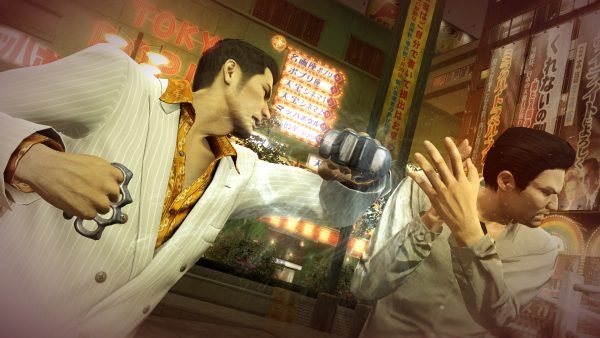 This all sounds very complex and a bit much if you’re new, but the game unlocks those styles one after another, so that it’s much easier to get used to them. Beginners can bet their or Kiryu/Majima’s backside on Brawler/Thug to getth em through for a while, this style sports easy button combinations on Square and Triangle respectively for a continuous flow of attacks. The so called “Heat” ability is one of the pillars of the battle system besides the three different fighting styles. Hitting on an opponent (you can see that as taunting them as well) will fill the Heat gauge (up to three bars) throughout the fights. So you filled out one, two or three bars of the gauge? Splendid, because that enables you to dish out special “finishers” in the game that are much more violent and usually extremely badass to look at. For example, you can drop that furniture on an enemy and jump on it for extra damage; or do a bodyslam on them to clean up the streets of Kamurocho or Sotenbori much faster and in style.
This all sounds very complex and a bit much if you’re new, but the game unlocks those styles one after another, so that it’s much easier to get used to them. Beginners can bet their or Kiryu/Majima’s backside on Brawler/Thug to getth em through for a while, this style sports easy button combinations on Square and Triangle respectively for a continuous flow of attacks. The so called “Heat” ability is one of the pillars of the battle system besides the three different fighting styles. Hitting on an opponent (you can see that as taunting them as well) will fill the Heat gauge (up to three bars) throughout the fights. So you filled out one, two or three bars of the gauge? Splendid, because that enables you to dish out special “finishers” in the game that are much more violent and usually extremely badass to look at. For example, you can drop that furniture on an enemy and jump on it for extra damage; or do a bodyslam on them to clean up the streets of Kamurocho or Sotenbori much faster and in style.
Under “Abilities” in the main menu, you’re able skill those six battle styles and learn new combos, increase your health bar and the Heat regeneration. To do that, you have to spend quite a bit of cash and you will need it, even though story missions give you quite the hefty haul of money for completing them. Later in the game attacks and skills will cost quite the penny or Yen in that case, ¥50.000 (aprox. 380 Euro) per skill/action. You may get a lot of cash in the game, but don’t take it for granted; Yakuza 0 doesn’t do that for free, everything in the game has it’s price. The skill tree allows the players to expand their two fighters in different ways and find their own favorite techniques to keep them motivated to use them until the end. All that while missions, mini games and side-quests fill the emptied coffers of our protagonists with new, much needed money, so that they once again can spend it on their moves, to dish out the pain much harder, better and faster.
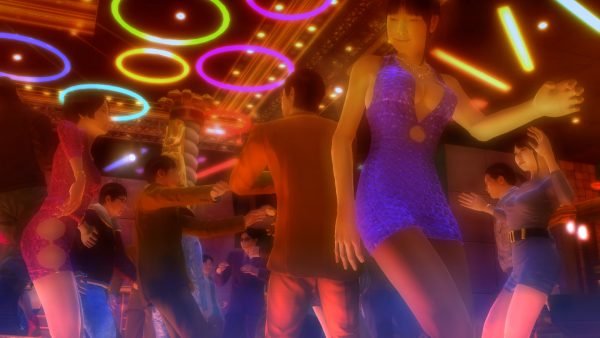 There’s some backlog to do by SEGA regarding explanation and tutorials to the Master level. There are certain attacks in the game that weren’t unlockable while we played from finish to the end. Only through web research we were able to ascertain that there were certain trainers in the game that could have unlocked them. For example you can sharpen up Majima’s weapon skills with the most bizarre close combat weapons you might have seen or make Kiryu much more agile in terms of evasion.
There’s some backlog to do by SEGA regarding explanation and tutorials to the Master level. There are certain attacks in the game that weren’t unlockable while we played from finish to the end. Only through web research we were able to ascertain that there were certain trainers in the game that could have unlocked them. For example you can sharpen up Majima’s weapon skills with the most bizarre close combat weapons you might have seen or make Kiryu much more agile in terms of evasion.
The AI in the game may not be very “intelligent” or deadly regarding random encounters in the streets, but it proves much more challenging in the epic boss fights of the game. You have to use combos and the combat styles with much more caution to be able to exploit the clan leader’s weaknesses.
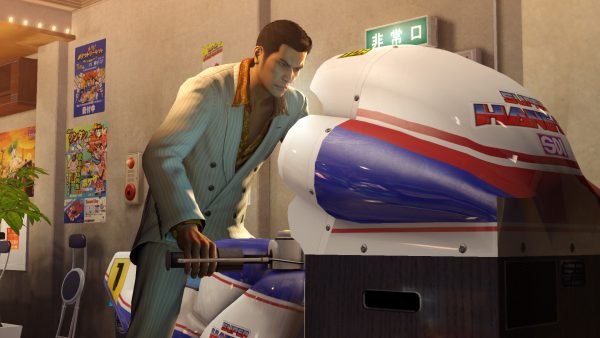 While Kiryu has his share of problems and fun in Kamurocho, there’s Majima everywhere in Sotenburi. Both localities have in common that they have their fair share of similar supermarkets and temples but they sport a different flair than in Kamurocho than in Sotenburi. Kamurocho is – as said before – the Entertainment district of Tokyo in which every neon sign is more vibrant and more extravagant than the other, has the ability to draw out the night life like no other. At day drunkards, students and your run of the mill business men hang out in the relatively dirty and gray streets. Those who followed the games up to this point already know its layout like the back of their hand. But since the game actually takes place around 20 years before the first Yakuza game, much of the already established businesses are still under construction. Arcades are all the rage in the 1988 version of the cities and instead of seeing “CLUB SEGA” greeting us as usual the “SEGA Hi-Tech Land” takes its place. Both arcade chains are based on their actual real life counterpart in Japan, completely without funny fantasy names that hold their own in Rockstar’s GTA series. You will find much to do in the cities under the term “mini games” like playing old SEGA classics that go by the name of Out Run, Super Hang-On, Space Harrier and Fantasy Zone for example. You may even buy into real estate and manage them, do pocket racer tournaments, karaoke or even baseball.
While Kiryu has his share of problems and fun in Kamurocho, there’s Majima everywhere in Sotenburi. Both localities have in common that they have their fair share of similar supermarkets and temples but they sport a different flair than in Kamurocho than in Sotenburi. Kamurocho is – as said before – the Entertainment district of Tokyo in which every neon sign is more vibrant and more extravagant than the other, has the ability to draw out the night life like no other. At day drunkards, students and your run of the mill business men hang out in the relatively dirty and gray streets. Those who followed the games up to this point already know its layout like the back of their hand. But since the game actually takes place around 20 years before the first Yakuza game, much of the already established businesses are still under construction. Arcades are all the rage in the 1988 version of the cities and instead of seeing “CLUB SEGA” greeting us as usual the “SEGA Hi-Tech Land” takes its place. Both arcade chains are based on their actual real life counterpart in Japan, completely without funny fantasy names that hold their own in Rockstar’s GTA series. You will find much to do in the cities under the term “mini games” like playing old SEGA classics that go by the name of Out Run, Super Hang-On, Space Harrier and Fantasy Zone for example. You may even buy into real estate and manage them, do pocket racer tournaments, karaoke or even baseball.
Majima in Sotenbori on the other hand has intriguing quests as well. He advertises his Cabaret Club “Grand” on the streets, funny dialogues, slogans and all, to attract new hostesses for his establishment. You’re able to tweak and customize the look of those who work for you or rather him and manage the different sections of the club as well. Here you have to look out for the preferences and likings of the customers and naturally to keep wranglers either at bay or throw them out. Who would be a better bouncer than the Majima himself? Ladies Wrestling is another mini game in Yakuza 0, the player can’t influence the fights directly but they are certainly a sight to behold. If you want to lay a hand on an opponent yourself then you have to go to the Underground Colosseum, to test your mettle against over a dozen of individual fighters. Also darts and pool are still there, oh players of old.
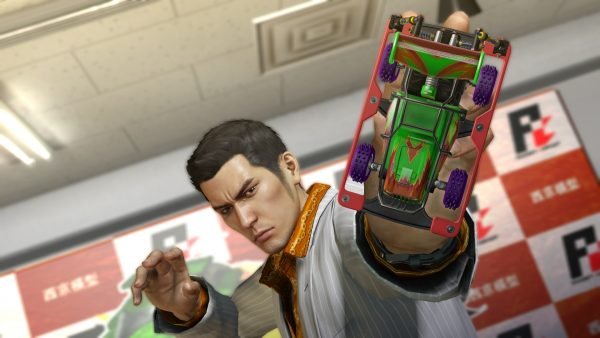 Yakuza 0 not only gives players a vast variety of mini games, they are not only a fun and entertaining way to lose money, no. Those little games are so intricate and well made, SEGA could very well release them as a spin-off series of their own. A small selection of them is also available for online cooperative play, so those who are interested in giving the game a chance can even play against others in mahjong and poker. Sadly there’s no invitation system in place, so you can’t specifically choose your friends but for all who are in it to win, there are online leaderboards in place.
Yakuza 0 not only gives players a vast variety of mini games, they are not only a fun and entertaining way to lose money, no. Those little games are so intricate and well made, SEGA could very well release them as a spin-off series of their own. A small selection of them is also available for online cooperative play, so those who are interested in giving the game a chance can even play against others in mahjong and poker. Sadly there’s no invitation system in place, so you can’t specifically choose your friends but for all who are in it to win, there are online leaderboards in place.
To top this entire amazing package of content off there are a lot of sub-stories as well. Sidequests, some shorter, some longer than others, tell a story out of character’s lives. Those go from extremely bizarre to extremely questionable at times in a fun way. For example Majima has to take on the role of the gallant boyfriend of a complete stranger infront of their father for one dinner. Or he has to escort a living statue in it’s desperation to the rest room, help a boy to retrieve a Super Nintendo like cartridge or even help a teen to his first dirty magazine, even though Majima normally does not entertain such actions.
Visual Design and Execution
SEGA constantly improves their designs and their engine to create a more believable look for the series. Yakuza 0 yet again manages to impress with its visual style and presentation, giving the players the possibly most impressive look the Yakuza franchise has had to this day. Kamurocho is livelier than ever especially when you consider the PS2 and PS3 games. Lots of pedestrians to walk up or into, neon signs are lighting the streets ever so colorful while the backstreets pile up with trash and small food stands exude steam in the cold winter days. Even the ingame models are much more detailed than before; antialiasing takes care of needless flickering and the games enhanced field of view contributes to the portrayal of a living city where there is much going on.
Loading times prove to be much shorter than in the previous console generations and diving straight into an encounter on the streets only takes a few seconds. Be that as it may, even the current game still suffers under the limitations of it’s technical foundation. Invisible walls, goons vanish into thin air after pummeling them into submission and drop weapons where you can’t get to them (clipping errors hurray).
Yakuza 0 in our Let’s Play from start to finish
Conclusion
Yakuza 0 is the ideal entry point to the long lasting 12 year-old series. The game builds upon the strong point of its predecessors with ease so that the combat system, the emotionally-gripping, intriguing story and the myriad of side missions and mini games shine even more brilliantly than before. But there’s still room for improvement on the technical side of the game that could make the experience all the more pleasant. Seldom has a videogame managed to be more entertaining and at the same time informative about the Japanese culture and its history than Yakuza 0. No matter if you are a fan of the long established series or completely new to it, we at XTgamer can only recommend the series and especially Yakuza 0 as an entry point to you, just in case you own a PlayStation 4 and are in need of something new and different.
We took the screenshots using the PS4 version.



